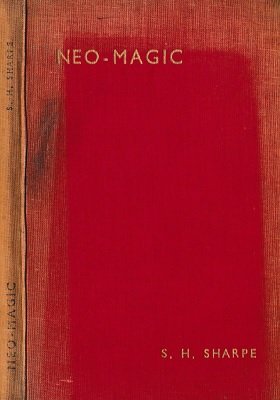$25(2 customer ratings) ★★★★★

The art of the conjurer.
Neo-Magic is the foundation for all of Sharpe's writing. Sharpe offers great insight into what makes magic magical. Starting with an analysis of art and its relationship to magic, Sharpe explores what he feels is needed for magic to become a fine art. He provides his insight into topics as originality, patter, styles of presentation, program construction, stage fright and others.
From the preface to the second edition:
What I have been doing over a considerable number of years is to find out, if possible, whether the answer to the question "Is conjuring a Fine Art?" should be "Yes" or "No," I long since came to the conclusion that neither of these is the answer, whatever the subject concerned. The question is wrong. It should be - "Can conjuring (or whatever you are discussing) be a Fine Art?" The answer in this case being: "Only if the craftsman is himself a Fine Artist." There is no such thing as a Fine Art per se. Not only must each specimen be considered individually; but the onlooker is incapable of assessing any work of art except by his own reactions to it. What seems to him a vulgar production may have been the artist's supreme effort at creating beauty according to his own lights; and what overcomes the same onlooker with sudden glory may have been a mere "pot-boiler" to its maker, whose best work was on a much more esoteric plane. It all depends on one's spiritual development.
- PREFACE TO THE SECOND EDITION
- ACKNOWLEDGEMENT
- ODE TO A MAGICIAN
- INTRODUCTION
- CHAPTER I. CONJURING AS A FINE ART
- I. The Nature of Art
- II. The Nature of Conjuring
- III. Critical Objections to Conjuring as an Art
- IV. Showmanship
- V. Order of Merit of Conjuring Effects
- VI. Popularity
- CHAPTER II. GRADES OF ART
- I. False Art
- II. Formal Art
- III. Naturalistic Art
- IV. Imaginative Art
- V. Absolute or Abstract Conjuring
- CHAPTER III. THE ORIGINATOR
- I. Conjurers Classified
- II. Originality
- III. Systematic Invention of Formal Effects
- IV. Forms of Assistance
- V. Analysis of Magical Plots
- VI. New Dramatic Plots
- VII. Copyright
- CHAPTER IV. PATTER
- I. Types of Patter
- II. Narrative Patter
- III. Composition of Patter
- IV. Making Magic Convincing
- V. Complication and Climax
- VI. Tragedy and Farce
- VII. Comedy in Conjuring
- VIII.
- IX.
- CHAPTER V. THE CONJURER
- I. The Inventor and Manufacturer
- II. The Executive Conjurer
- III. Desirable Qualities in a Conjurer
- IV. Mastering the Craft
- CHAPTER VI. PRODUCTION
- I. Necessity of a Producer
- II. Advertising
- III. Styles of Presentation
- IV. The Magical Sketch
- V. Logic
- VI.
- VII. Consistency
- VIII. Unfounded Suspicion
- IX. On Leaving the Stage
- X. Dramatic Types
- XI. Preparing Against a Contretemps
- CHAPTER VII. PRODUCTION (continued)
- I.
- II. Audiences
- III. Choice of Apparatus
- IV. More About Audiences
- V. Order of Effects
- VI. Surprise, Repetition and Transition
- VII. Holding Attention
- VIII. Separate Item v. Sequenced Programme
- IX. Pattern Programmes
- X. Incidentals
- CHAPTER VIII. PRODUCTION (continued)
- I. Interest
- II. Stage Fright
- III. Emotional Appeal
- IV. Scene
- V. Schools of Conjuring
- IV. The Legitimate Use of Apparatus
- CHAPTER IX. PRODUCTION (continued)
- I. Action
- II. Sound
- III. Music
- CHAPTER X. THE CRITIC
- I. Constructive Criticism
- II. Objects of Criticism
- III Exposure
- IV. Magic and Music
- V. Exposing Minor Effects
- IV. Exposing Sleight of Hand and Stage Magic
- VII. Immunity of the Artist
- VIII. Better Conjuring
- IX. Mediums of Exposure
- X. Conclusion
1st edition 1932; 2nd edition 1946, 130 pages; 1st digital edition 2019, 117 pages.
word count: 50753 which is equivalent to 203 standard pages of text